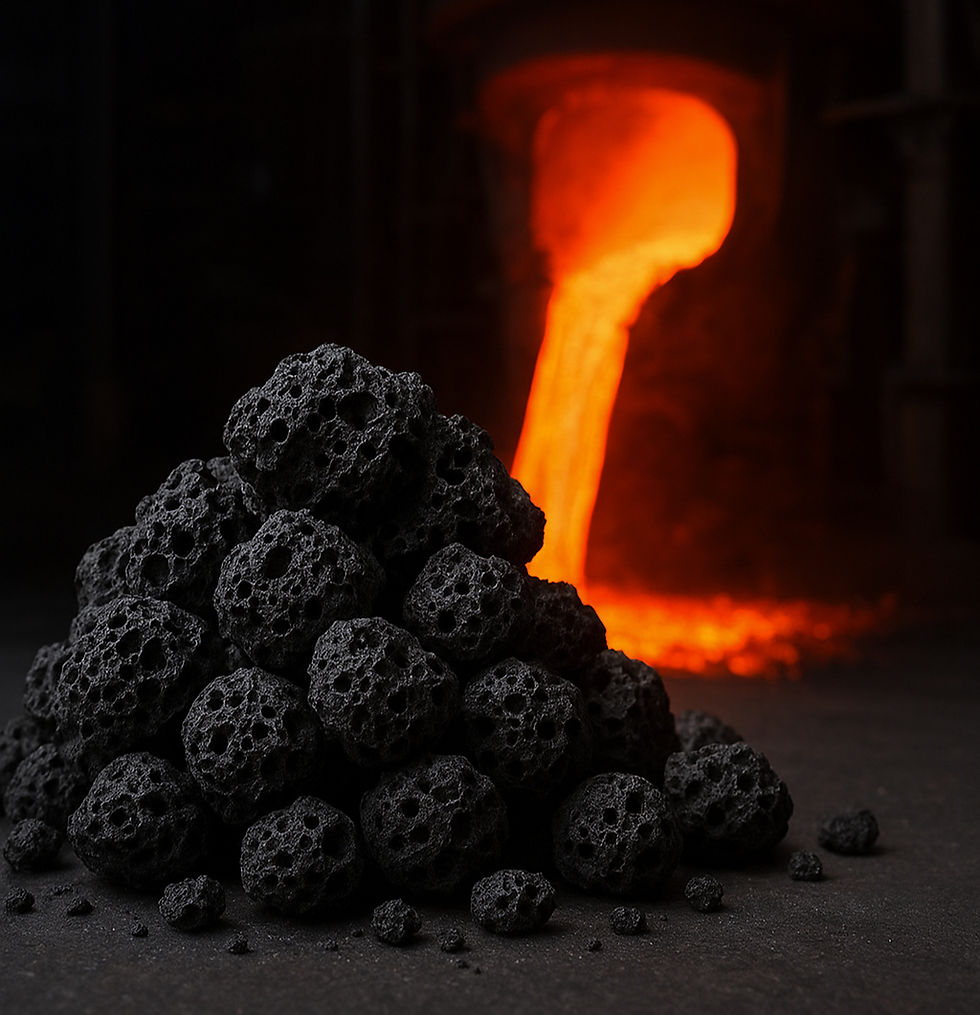Biochar in Metallury: From Fossil Carbon Replacement to Verified Carbon Offsets
- Careis Hung
- Aug 29
- 3 min read
Metallurgy is tough to decarbonize but biochar can be used as an effective carbon reduction solution. Read on to find out more!

Metallurgy—the backbone of modern industry—remains one of the toughest sectors to decarbonize. The reason is simple but stubborn: coal and coke serve a dual role inside furnaces and smelters. They are not only the fuel that generates the extreme heat required to process ores, but also the chemical reducing agents that strip oxygen from metal oxides to release pure metals.
In other words, fossil carbon is both the fire and the chemistry.
This dual dependency has long locked the sector into high emissions. However, biochar offers a breakthrough. Derived from sustainably sourced biomass, biochar can fulfil both roles—supplying reactive carbon for reduction while contributing energy—and at the same time act as a durable carbon sink when applied in soils or industrial byproducts.
This positions biochar as more than a replacement input. It is a pathway to verified carbon offsets, bridging industrial decarbonization with long-term carbon removal.
#1 - Emission Reduction in Metallurgy
Biochar produced from sustainably sourced biomass can act both as a replacement for fossil carbon in metallurgical processes and as a persistent carbon sink when applied in soil or slag conditioning. This dual use paves the way for generating verified carbon credits:
Partial substitution in steelmaking: Studies show biochar can replace 5 % to 50 % of coal/coke in processes like sintering, blast furnace injection, and electric arc furnaces—typically around 20–25% substitution is operationally feasible while preserving performance. CO₂ reductions range from 5 % up to 50%, depending on the application and substitution ratio.
Emission-offset mechanism: Since biochar carbon is derived from biomass that captured CO₂ during growth (biogenic carbon), using it in place of fossil carbon avoids additional net CO₂ emissions—moving toward potentially carbon-neutral metallurgy.
#2 - Carbon Credit Eligibility & Standards
To translate these gains into marketable carbon offsets, rigorous standards are required.
Biochar as long-term carbon sink: Standards like the European Biochar Certificate and the Global Biochar C‑Sink Standard (launched June 2024) define “permanent aromatic carbon” and approve projects for long-term sequestration credit eligibility.
Quality & sustainability certifications: The World Biochar Certificate (WBC) provides certification for biochar quality and sourcing, ensuring compliance with emission regulations and contaminant limits.
Carbon offset methodologies: Protocols—such as those from Verra (VCS VM0044) and Puro.earth and Isometric—are being developed to explicitly accommodate biochar-based CO₂ removal and substitution within industrial processes.
Puro.earth, a Nasdaq-owned platform for carbon removal, has issued over 1 million CO₂ Removal Certificates (CORCs) since 2019.
#3 - Industrial Integration & Case Studies
Several pilot and industrial-scale projects demonstrate viable pathways to use biochar in metallurgy applications.
Electric Arc Furnace (EAF) injection: Biochar can replace anthracite or coke, acting as a foaming and carbon cushion, reducing Scope 1 CO₂ emissions. Pilot tests report up to 18 % emission reductions when replacing ~15 % of carbon inputs—without compromising quality.
Australian steel trials: Arrium and BlueScope Steel partnered with CSIRO to develop biochar-based ironmaking with potential CO₂ reductions of 32–58%, especially through tuyere injection in blast furnaces. Australia could produce ~1 Mt/year of such biochar cost-effectively.
#4 - Carbon Credit Value & Market Trends
The carbon credit market for biochar is rapidly expanding, particularly in the voluntary carbon market (VCM), where demand for durable carbon dioxide removal (CDR) solutions is growing. Biochar stands out because it not only avoids fossil carbon emissions (via substitution in metallurgy) but also sequesters carbon for centuries to millennia when applied to soil or incorporated into industrial byproducts like slag.
According to a 2024 market analysis by CDR.fyi, biochar accounted for over 94% of all durable carbon removal credits delivered globally. This dominance is due to its verifiable sequestration, rapid scalability, and relatively low cost per ton of CO₂ removed.
Conclusion
Biochar carbon credits are rapidly gaining momentum in global carbon markets. With rising credit prices, increasing corporate demand, and rigorous certification frameworks (Puro.earth, Verra VCS, EBC), biochar is becoming a central tool in both industrial decarbonization and carbon removal finance. Its unique role in metallurgy—as both a process decarbonizer and a permanent carbon sink—positions it as one of the most financially viable and environmentally credible tools for generating carbon offsets today.
If you are keen to explore partnerships, pilots, or applications, reach out to us at chloe@greenchar.co





Comments